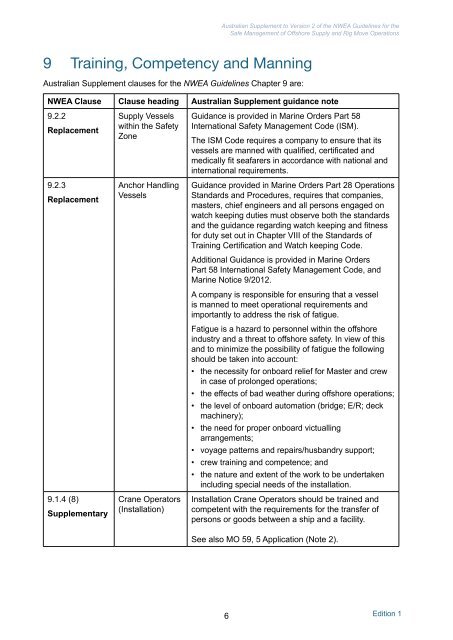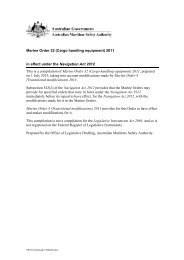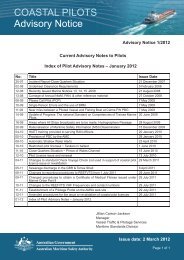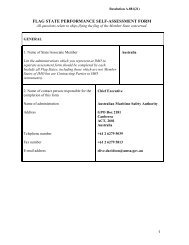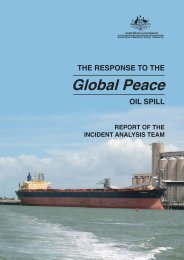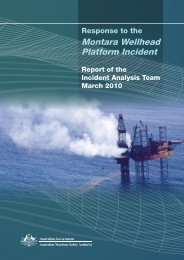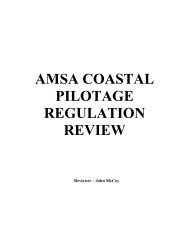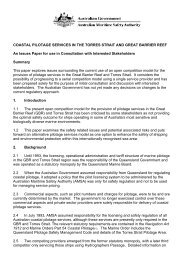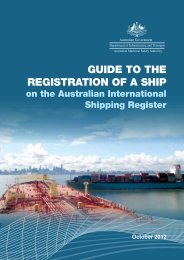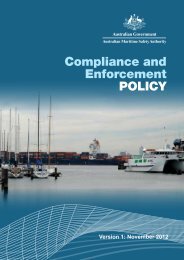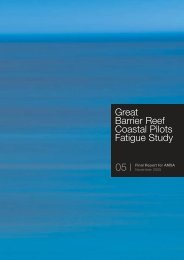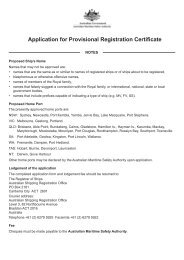Australian Supplement to - Australian Maritime Safety Authority
Australian Supplement to - Australian Maritime Safety Authority
Australian Supplement to - Australian Maritime Safety Authority
Create successful ePaper yourself
Turn your PDF publications into a flip-book with our unique Google optimized e-Paper software.
<strong>Australian</strong> <strong>Supplement</strong> <strong>to</strong> Version 2 of the NWEA Guidelines for the<br />
Safe Management of Offshore Supply and Rig Move Operations<br />
9 Training, Competency and Manning<br />
<strong>Australian</strong> <strong>Supplement</strong> clauses for the NWEA Guidelines Chapter 9 are:<br />
NWEA Clause Clause heading <strong>Australian</strong> <strong>Supplement</strong> guidance note<br />
9.2.2<br />
Replacement<br />
9.2.3<br />
Replacement<br />
9.1.4 (8)<br />
<strong>Supplement</strong>ary<br />
Supply Vessels<br />
within the <strong>Safety</strong><br />
Zone<br />
Anchor Handling<br />
Vessels<br />
Crane Opera<strong>to</strong>rs<br />
(Installation)<br />
Guidance is provided in Marine Orders Part 58<br />
International <strong>Safety</strong> Management Code (ISM).<br />
The ISM Code requires a company <strong>to</strong> ensure that its<br />
vessels are manned with qualified, certificated and<br />
medically fit seafarers in accordance with national and<br />
international requirements.<br />
Guidance provided in Marine Orders Part 28 Operations<br />
Standards and Procedures, requires that companies,<br />
masters, chief engineers and all persons engaged on<br />
watch keeping duties must observe both the standards<br />
and the guidance regarding watch keeping and fitness<br />
for duty set out in Chapter VIII of the Standards of<br />
Training Certification and Watch keeping Code.<br />
Additional Guidance is provided in Marine Orders<br />
Part 58 International <strong>Safety</strong> Management Code, and<br />
Marine Notice 9/2012.<br />
A company is responsible for ensuring that a vessel<br />
is manned <strong>to</strong> meet operational requirements and<br />
importantly <strong>to</strong> address the risk of fatigue.<br />
Fatigue is a hazard <strong>to</strong> personnel within the offshore<br />
industry and a threat <strong>to</strong> offshore safety. In view of this<br />
and <strong>to</strong> minimize the possibility of fatigue the following<br />
should be taken in<strong>to</strong> account:<br />
• the necessity for onboard relief for Master and crew<br />
in case of prolonged operations;<br />
• the effects of bad weather during offshore operations;<br />
• the level of onboard au<strong>to</strong>mation (bridge; E/R; deck<br />
machinery);<br />
• the need for proper onboard victualling<br />
arrangements;<br />
• voyage patterns and repairs/husbandry support;<br />
• crew training and competence; and<br />
• the nature and extent of the work <strong>to</strong> be undertaken<br />
including special needs of the installation.<br />
Installation Crane Opera<strong>to</strong>rs should be trained and<br />
competent with the requirements for the transfer of<br />
persons or goods between a ship and a facility.<br />
See also MO 59, 5 Application (Note 2).<br />
6<br />
Edition 1


